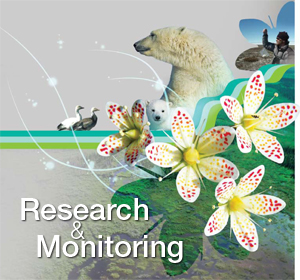
Research and monitoring
Wapusk National Park
 Research and monitoring
Research and monitoring Research and monitoring programs are important tools that can be used to gain an understanding of ecological resources and processes in the park.
Research projects enable scientists to study conditions and species within the park to determine whether they are unique or specific to this landscape or are behaving in a way that has not been documented elsewhere.
Research projects for 2024-25 include:
- Investigating the formation and evolution of beach ridges as a function of ice dynamics and local hydrography, Kaushik Gupta (University of Manitoba)
- Understanding arctic Grizzly Bear range expansion: A community-oriented approach, Dr. Doug Clark (University of Saskatchewan)
- Wapusk National Park University of Saskatchewan August Field School, Dr. Ryan Brook (University of Saskatchewan)
- Investigating Arctic fox food web interactions, Dr. James Roth (University of Manitoba)
- Influence of snow enhancement and nutrient additions by Arctic foxes on tundra plants at the Arctic’s edge, Dr. John Markham (University of Manitoba), with Dr. James Roth (University of Manitoba)
- Long-term monitoring of permafrost-vascular plant-soil moisture and habitat in and around Wapusk National Park, Julie Rogers (The Park School of Baltimore)
- The expansion of Lesser Snow Goose nesting in Wapusk National Park, Dr. Kit Uvino (University of Jamestown)
- Habitat Assessment in the Thompson Point Region of Wapusk National Park, Dr. Kit Uvino (University of Jamestown)
- Ecology and Habitat Impact of Snow Geese at La Pérouse Bay and on the Cape Churchill Peninsula, Dr. Kit Uvino (University of Jamestown)
- The Arctic Bears Project, Dr. Doug Clark (University of Saskatchewan) with Dr. Ryan Brook (University of Saskatchewan)
- Reconstructing lake and peatland dynamics during the industrial era in the Wapusk National Park near Churchill, Manitoba, Dr. Frédéric Bouchard (Université de Sherbrooke)
- Understanding limitations to invasions by non-native plants at high latitudes, Dr. Peter Kotanen (University of Toronto)
- Hudson–James Bay Lowlands Biodiversity Conservation and Sequestration Initiative, Dr. Alison Cassidy (Parks Canada)
- Ice-wedge distribution, development, and impacts on landscape evolution in the Barrens of the Hudson Bay Lowlands, Northern Manitoba, Tabatha Rahman (Université Laval)
- Post-breeding migratory behaviour of sub-arctic shorebirds in Wapusk National Park, Dr. Erica Nol (Trent University)
- Monitoring Golden Eagle Nesting in Wapusk National Parks Canada, Andrew Berry (Bernheim Arboretum and Research Forest, Kentucky)
- Microclimate, snowpack, treeline dynamics, and permafrost degradation in Wapusk National Park, Dr. Steve Mamet (University of Saskatchewan)
- The ecology, population dynamics, and status of polar bears (Ursus maritimus) in relation to environmental change, Dr. Evan Richardson (Environment and Climate Change Canada)
- Wapusk National Park scat (fecal) monitoring for Caribou, Russell Turner (Parks Canada)
- Boreal Landbird Monitoring Program, Steven Van Wilgenberg (Environment and Climate Change Canada)
- Candid Caribou: Documenting Migratory Habitat Use for Caribou in Wapusk National Park, Russell Turner (Parks Canada)
- Wapusk Snow Goose Breeding Survey: Mapping Colonies and Estimating Abundance, Russell Turner (Parks Canada)
- Influence of snow enhancement and nutrient additions by Arctic foxes on tundra plants at the Arctic’s edge, Dr. John Markham (University of Manitoba)
- Finventory – An eDNA Fisheries Inventory for Wapusk National Park, Erica Gillis (Parks Canada)
- Eyes on the Skies – Arctic Shorebird Monitoring in Wapusk National Park, Erica Gillis (Parks Canada)
- Sustaining permafrost monitoring to assess state of the park in Wapusk National Park, Erica Gillis (Parks Canada)
- Hydroecology of lakes in Wapusk National Park – Sustainable ecological integrity monitoring and research, Erica Gillis (Parks Canada)
- Researching the Impact of Lesser Snow Geese (Anser caerulescens) on the Ecological Integrity of Northern Manitoba Landscapes, Emma Dicks (University of Manitoba)
- Examining fox interactions and movements at tundra-taiga transition, Dr. James Roth (University of Manitoba)
Monitoring programs enable scientists and managers through repeated assessment to look at the systems and determine if they are changing over time and whether these changes are related to natural processes or are due to human impact. Monitoring also allows park managers to determine the effectiveness of management actions.
One of the most important aspects of research and monitoring is communicating the results and information to the people outside the science program, to local communities, and to assist in making other researchers aware of the research and monitoring going on in the park.
Annual Report of Research and Monitoring 2015-2016 (PDF, 4.2 MB)
Annual Report of Research and Monitoring 2011-2012 (PDF, 4 MB)
Annual Report of Research and Monitoring 2010-2011
The Wapusk National Park Management Plan highlights Parks Canada’s responsibility for maintaining and monitoring ecological integrity in the Park. Collaborations with universities, government agencies and not-for-profit organizations enhance our collective ability to measure the critical issues that may affect ecological integrity in the Park and surrounding area, and to better understand them.
Churchill Northern Studies Centre (CNSC), Parks Canada staff and researchers met in January 2011 in Winnipeg to share scientific research findings and develop ideas for future research priorities in the greater Churchill region. Following this successful symposium, CNSC worked with Parks Canada to produce the 2011 Annual Report of Research & Monitoring for Wapusk National Park. Please email Email address: manitoba@pc.gc.ca for a copy of the report, which provides summaries of research being conducted in and around the park.
Annual Report of Research and Monitoring 2009-2010 (PDF, 3 MB)
Annual Report of Research and Monitoring 2007-2008 (PDF, 2.43 MB)
The Birds of Wapusk National Park. 2009. Occasional Paper No. 1. (PDF, 3.9 MB)
- Date modified :